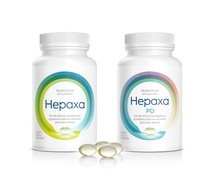미디어
Benefits of omega-3 long-chain fatty acids in patients with non-alcoholic fatty liver disease revealed in meta-analysis of 18 studies
Ludwigshafen, Germany – August 16, 2018 – Nutrition Reviews® published a systematic review and meta-analysis of 18 controlled intervention studies on the effectiveness of omega-3 long-chain polyunsaturated fatty acids (n-3 LC-PUFAs) in patients with non-alcoholic fatty liver disease (NAFLD). The aim of this review was to systematically assess the effects of n-3 LC-PUFAs, particularly eicosapentaenoic acid (EPA) and docosahexaenoic acid (DHA), on liver-related and metabolic outcomes in adult and pediatric patients with NAFLD.
Based on the meta-analysis, dietary management with n-3 LC-PUFAs resulted in statistically significant improvements in liver fat content, steatosis score, and several cardiometabolic risk factors. According to this newly-published research, the minimum effective daily intakes are 250mg of DHA in pediatric patients and approximately 3.0g of EPA & DHA in adult patients. The authors concluded that, in addition to following a sensible eating plan and increasing physical activity levels, adult and pediatric patients with NAFLD should be encouraged to increase their intakes of n-3 LC-PUFAs.
Further studies[i] have shown that patients with NAFLD have lower levels of EPA and DHA compared to patients without NAFLD. BASF launched Hepaxa™ in February 2018 in the U.S. as the first-to-market, dedicated product for the dietary management of patients with NAFLD. Hepaxa increases the levels of these important fatty acids in patients with NAFLD, which improves the liver´s ability to process fat in the liver.
“The meta-analysis provides further evidence that increasing the intake of n-3 LC-PUFAs can help with the dietary management of NAFLD,” says Christoph Garbotz, Head of Commercial Management Advanced Health Solutions, BASF. “Hepaxa is a breakthrough in the nutritional support options for patients with NAFLD – in addition to a healthy diet and exercise, Hepaxa can help turn early-stage NAFLD around. Hepaxa is uniquely positioned to support tens of millions of patients affected by NAFLD, one of the most common forms of chronic liver disease.”
Hepaxa is manufactured using a patented purification technology, which removes persistent organic pollutants and other unwanted lipids, such as cholesterol, that are naturally found in many fish oil-based products. Research has shown that one specific pollutant, PCB 153, is particularly harmful to NAFLD patients. As the liver function of NAFLD patients is compromised, it is important to limit exposure to unwanted components that are present in many less-refined fish oils. Hepaxa has an excellent safety profile. It is GRAS (Generally Recognized As Safe) for use as a medical food for the dietary management of NAFLD at intakes of up to 3 g/day of EPA & DHA for both adults and pediatrics 10 years of age and older.
Hepaxa is available as a medical food product in the U.S. to patients 10 years and older with NAFLD for use under physician supervision. Hepaxa is distributed nationally through DIEM Labs, LLC. Physicians and healthcare professionals may request clinical support literature and product samples, and patients can gather information to share with their physicians, at www.Hepaxa-USA.com.
About BASF’s Nutrition & Health division
BASF Nutrition & Health provides a comprehensive product and service portfolio for the human and animal nutrition, pharmaceutical and flavor & fragrance industries. With innovative solutions and modern technologies, we help our customers improve their business efficiency and the sustainability of their products. Our human nutrition solutions include vitamins and carotenoids, plant sterols, emulsifiers and omega-3 fatty acids. Vitamins and carotenoids also form an important part of our animal nutrition portfolio, as do other feed additives such as trace elements, enzymes and organic acids. We provide the pharmaceutical industry with a broad range of excipients and selected large-volume active pharmaceutical ingredients such as ibuprofen and omega-3 fatty acids. Furthermore, we offer aroma ingredients such as citral, geraniol and L-menthol. BASF Nutrition & Health operates sites in Europe, North America, South America and in Asia-Pacific. For more information, go to www.basf.com.
About BASF
At BASF, we create chemistry for a sustainable future. We combine economic success with environmental protection and social responsibility. The more than 115,000 employees in the BASF Group work on contributing to the success of our customers in nearly all sectors and almost every country in the world. Our portfolio is organized into five segments: Chemicals, Performance Products, Functional Materials & Solutions, Agricultural Solutions and Oil & Gas. BASF generated sales of €64.5 billion in 2017. BASF shares are traded on the stock exchanges in Frankfurt (BAS), London (BFA) and Zurich (BAS). Further information at www.basf.com.
______________________
[i] Allard JP, Aghdassi E, Mohammed S, Raman M, Avand G, Arendt BM, et al. Nutritional assessment and hepatic fatty acid composition in non-alcoholic fatty liver disease (NAFLD): A cross-sectional study. J Hepatol 2008;48:300–7. doi:10.1016/j.jhep.2007.09.009.
Araya J, Rodrigo R, Videla L, Thielemann L, Orellana M, Pettinelli P, et al. Increase in long-chain polyunsaturated fatty acid n - 6/n - 3 ratio in relation to hepatic steatosis in patients with non-alcoholic fatty liver disease. Clin Sci 2004;106:635–43. doi:10.1042/CS20030326.
Pettinelli P, del Pozo T, Araya J, Rodrigo R, Araya AV, Smok G, et al. Enhancement in liver SREBP-1c/PPAR-α ratio and steatosis in obese patients: Correlations with insulin resistance and n-3 long-chain polyunsaturated fatty acid depletion. Biochim Biophys Acta - Mol Basis Dis 2009;1792:1080–6. doi:10.1016/j.bbadis.2009.08.015.
Elizondo A, Araya J, Rodrigo R, Poniachik J, Csendes A, Maluenda F, et al. Polyunsaturated fatty acid pattern in liver and erythrocyte phospholipids from obese patients. Obesity 2007;15:24–31. doi:10.1038/oby.2007.518.
Rose M, Veysey M, Lucock M, Niblett S, King K, Baines S, et al. Association between erythrocyte omega-3 polyunsaturated fatty acid levels and fatty liver index in older people is sex dependent. J Nutr Intermed Metab 2016;5:78–85. doi:10.1016/j.jnim.2016.04.007.
P-18-292


